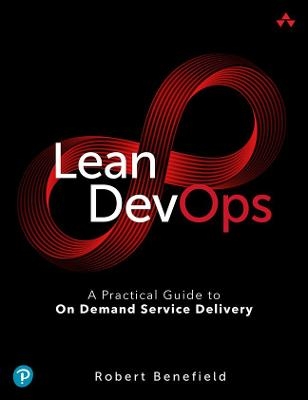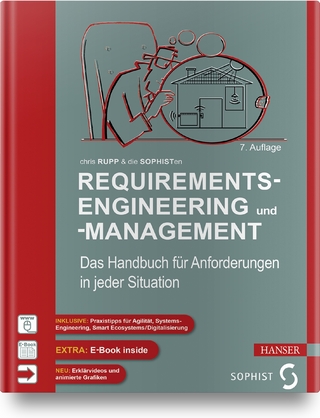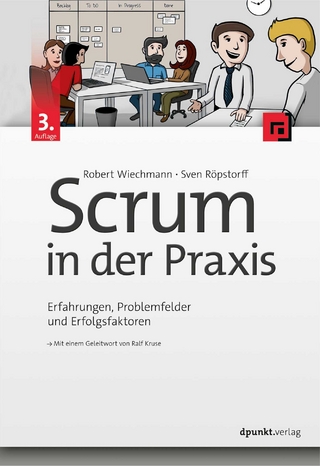
Lean DevOps
Addison Wesley (Verlag)
978-0-13-384750-5 (ISBN)
As service stacks grow more complex, it becomes even tougher to deliver on-demand IT services that meet customers' expectations for speed, consistency, reliability, security, privacy, and value. Layering on new cloud technologies, architectural approaches, or methodologies can aggravate the problem by widening the gap between what delivery teams think they're delivering and what customers actually experience. In Lean DevOps, technical leader Robert Benefield helps you escape this spiral, reverse bad habits, and regain the situational awareness you need to deliver the right services in the right way.
Writing for delivery team members and their leaders, Benefield shows how to improve information flow throughout your organization, so you can move toward your customers' target outcomes. He identifies problems arising from traditional approaches to managing teams, debunks excuses often used to prevent progress, and offers realistic recommendations for everything from requirements to incentives.
* Understand key dynamics that impact service delivery, and avoid focusing on the wrong issues
* Give your delivery teams stronger abilities to learn and improve
* Improve team maturity and implement prerequisites for effective use of automation and AI/ML
* Optimize key service delivery elements, from instrumentation to queue masters and cycles
* Organize and manage workflows more effectively
* Handle governance associated with internal controls and external legal/regulatory requirements
* Leverage the power of Lean and Mission Command to accelerate innovation, empower subordinates, and drive the outcomes you want
Robert Benefield is an experienced technical leader who has decades of experience delivering robust on-demand services to solve hard problems in demanding ecosystems including banking and securities trading, medical and pharmaceutical, energy, telecom, government, and Internet services. His continual eagerness to learn and work with others to make a difference has taken him from building computers and writing code in the early days of the Internet at Silicon Valley startups to the executive suite in large multinational companies. He shares his unique experience in the hopes that others can continue to build on it without having to collect quite as many scars along the way.
Introduction 1
Chapter 1: The Problem with IT Service Delivery 7
Approach #1: Reduce Delivery Friction 9
The Downsides of Targeting Delivery Friction 11
Approach #2: Managing Service Delivery Risk 12
The Downsides of Targeting Service Delivery Risk 14
The Essence of Delivery 15
Beginning the DevOps Journey 17
Summary 18
Chapter 2: How We Make Decisions 21
Examining the Decision-Making Process 22
Boyd and the Decision Process 23
The OODA Loop 26
The Ingredients of Decision Making 29
Ingredient 1: The Target Outcome 30
Delivering Measures over Outcomes 36
Ingredient 2: Friction Elimination 39
Ingredient 3: Situational Awareness 42
The Challenge of Trust 44
The Fragility of Mental Models and Cognitive Biases 45
Ingredient 4: Learning 48
Failing to Learn 48
The Pathway to Improved Decision Making 53
Summary 54
Chapter 3: Mission Command 55
The Origins of Mission Command 56
Learning How to Lead Effectively the Hard Way 57
Managing Through Unpredictability 58
Knowledge and Awareness Weaknesses 59
Misalignments 60
Misjudgment of Ecosystem Complexity 61
The Anatomy of Mission Command 62
Commander's Intent 63
Brief 66
Situational Overview 67
Statement of the Desired Outcome or Overall Mission Objective 67
Execution Priorities 67
Anti-Goals and Constraints 68
Backbriefing 69
Einheit: The Power of Mutual Trust 71
Creating Einheit in DevOps 74
Continual Improvement 75
Staff Rides 78
After Action Reviews 79
Organizational Impacts of Mission Command 80
Summary 81
Chapter 4: Friction 83
Understanding Ohno's Forms of Waste 84
Muda (Pure Waste) 86
Muri (Overburden) 109
Mura (Fluctuation and Irregularity) 113
See the Whole 125
Summary 126
Chapter 5: Risk 127
Cynefin and Decision Making 128
Ordered Systems 131
Unordered Systems 134
Reimagining Risk Management 143
Have Clear and Understood Target Outcomes 144
Make the Best Choice the Easiest Choice 145
Continually Improve Ecosystem Observability 147
Summary 151
Chapter 6: Situational Awareness 153
Making Sense of Our Ecosystem 154
The Mental Model 157
The Problems with Mental Models 158
Cognitive Bias 161
Gaining Better Situational Awareness 163
Framing 164
Finding and Fixing Framing Problems 165
Information Flow 169
Why Ecosystem Dynamics Matter 169
Meeting Your Information Flow Needs 172
Analysis and Improvement 181
Summary 182
Chapter 7: Learning 183
The Emergence of Skills Attainment Learning 184
The Rise of the One Right Way 186
Outcome-Directed Learning 188
Creating a Learning Culture 191
Day-to-Day Kata 191
Improvement and Problem-Solving Kata 192
The Coaching Practice 193
Summary 195
Chapter 8: Embarking on the DevOps Journey 197
The Service Delivery Challenge 204
Traditional Delivery Fog in the Service World 205
The Challenge of the "ilities" 207
The Path to Eliminating Service Delivery Fog 209
The Role of Managers in Eliminating Service Delivery Fog 210
Identifying What You Can or Cannot Know 214
Ways the Team Can Eliminate Service Delivery Fog 219
Summary 220
Chapter 9: Service Delivery Maturity and the Service Engineering Lead 221
Modeling Service Delivery Maturity 223
The Example of Measuring Code Quality 224
Service Delivery Maturity Model Levels 225
Service Delivery Maturity Areas of Interest 228
Configuration Management and Delivery Hygiene 232
Supportability 235
Single Point of Failure Mitigation and Coupling Management 239
Engagement 241
The Service Engineering Lead 243
Why Have a Separate Rotating Role? 244
How the SE Lead Improves Awareness 246
Organizational Configurations with the SE Lead 248
Challenges to Watch Out For 250
Incentivizing Collaboration and Improvement 251
Developers Running Production Services 253
Overcoming the Operational Experience Gap 254
Summary 256
Chapter 10: Automation 257
Tooling and Ecosystem Conditions 258
Building Sustainable Conditions 260
5S 261
Seeing Automation 5S in Action 278
Tools & Automation Engineering 283
Organizational Details 285
Workflow and Sync Points 285
Summary 287
Chapter 11: Instrumentation and Observability 289
Determining the "Right" Data 291
Know the Purpose and Value 293
Know the Audience 297
Know the Source 302
Making the Ecosystem Observable 307
Instrumenting for Observability 310
Instrumenting Development 310
Instrumenting Packaging and Dependencies 314
Instrumenting Tooling 316
Instrumenting Environment Change and Configuration Management 317
Instrumenting Testing 319
Instrumenting Production 320
Queryable/Reportable Live Code and Services 321
Presenting Task, Change, Incident, and Problem Records Together 321
Environment Configuration 322
Logging 323
Monitoring 324
Security Tracking and Analysis 325
Service Data 326
Pulling It All Together 327
Instrumenting a Wastewater Ecosystem 328
Instrumenting an IT Ecosystem 331
Summary 333
Chapter 12: Workflow 335
Workflow and Situational Awareness 336
Managing Work Through Process 337
Managing Work Organically 339
The Tyranny of Dark Matter 340
Learning to See the Disconnects in Action 343
Resolving Disconnects by Building Context 347
Visualizing the Flow 349
Workflow Board Basics 351
State Columns 352
State Columns for Operations 353
Swim Lanes 355
Task Cards 358
Preventing Dark Matter 359
Using the Board 362
Seeing the Problems 363
Limiting Work in Progress 365
The Limits of a Workflow Board 367
Managing the Board 367
Managing Flow and Improvement 368
Summary 368
Chapter 13: Queue Master 371
An Introduction to the Queue Master 372
Role Mechanics 374
"Follow the Sun" Queue Mastering 384
Queue Master Rollout Challenges 389
Team Members Don't See the Value 389
More Traditionally Minded Managers Thwarting Rollout 390
Pushy Queue Masters 391
Junior Team Members as Queue Masters 391
Queue Masters Who Struggle to Lead Sync Points 394
Summary 394
Chapter 14: Cycles and Sync Points 395
Inform, Align, Reflect, and Improve 396
Top-Down Alignment Control Approach 397
Alignment Through Iterative Approaches 397
Service Operations Synchronization and Improvement 400
The Tactical Cycle 400
Important Differences Between Kickoffs and
Sprint Planning 404
Daily Standup 408
Retrospective 411
General Meeting Structure 413
The Learning and Improvement Discussion 415
The Strategic Cycle 421
Strategic Review 424
General Review Structure 426
A3 Problem Solving for the Strategic Review 427
Summary 432
Chapter 15: Governance 433
Factors for Successful Governance 434
Meeting Intent 435
No Target Outcome Interference 437
Maintain Situational Awareness and Learning 438
Common Governance Mistakes 440
Poor Requirement Drafting and Understanding 440
Using Off-the-Shelf Governance Frameworks 445
Out-of-the-Box Process Tooling and Workflows 450
Tips for Effective DevOps Governance 453
Understand Governance Intent 454
Make It Visible 454
Propose Reasonable Solutions 456
Automation and Compliance 458
Be Flexible and Always Ready to Improve 458
Summary 460
Appendix 461
9780133847505 TOC 6/7/2022
| Erscheint lt. Verlag | 7.11.2022 |
|---|---|
| Verlagsort | Boston |
| Sprache | englisch |
| Maße | 188 x 234 mm |
| Gewicht | 900 g |
| Themenwelt | Informatik ► Software Entwicklung ► Agile Software Entwicklung |
| ISBN-10 | 0-13-384750-0 / 0133847500 |
| ISBN-13 | 978-0-13-384750-5 / 9780133847505 |
| Zustand | Neuware |
| Informationen gemäß Produktsicherheitsverordnung (GPSR) | |
| Haben Sie eine Frage zum Produkt? |
aus dem Bereich


